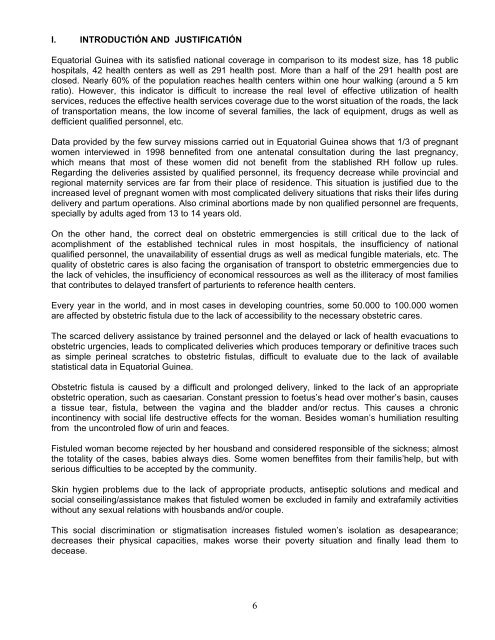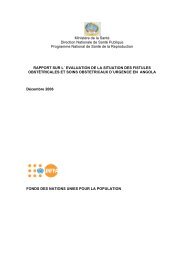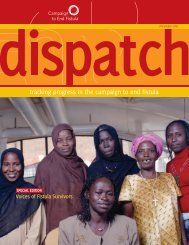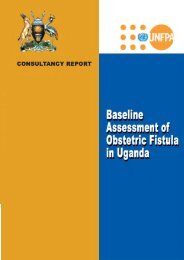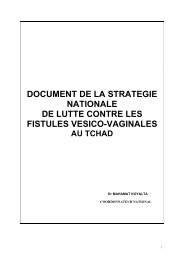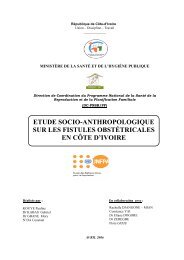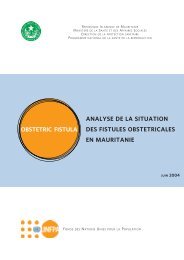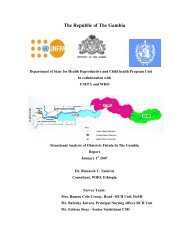Equatorial Guinea - Campaign to End Fistula
Equatorial Guinea - Campaign to End Fistula
Equatorial Guinea - Campaign to End Fistula
You also want an ePaper? Increase the reach of your titles
YUMPU automatically turns print PDFs into web optimized ePapers that Google loves.
I. INTRODUCTIÓN AND JUSTIFICATIÓN<br />
<strong>Equa<strong>to</strong>rial</strong> <strong>Guinea</strong> with its satisfied national coverage in comparison <strong>to</strong> its modest size, has 18 public<br />
hospitals, 42 health centers as well as 291 health post. More than a half of the 291 health post are<br />
closed. Nearly 60% of the population reaches health centers within one hour walking (around a 5 km<br />
ratio). However, this indica<strong>to</strong>r is difficult <strong>to</strong> increase the real level of effective utilization of health<br />
services, reduces the effective health services coverage due <strong>to</strong> the worst situation of the roads, the lack<br />
of transportation means, the low income of several families, the lack of equipment, drugs as well as<br />
defficient qualified personnel, etc.<br />
Data provided by the few survey missions carried out in <strong>Equa<strong>to</strong>rial</strong> <strong>Guinea</strong> shows that 1/3 of pregnant<br />
women interviewed in 1998 bennefited from one antenatal consultation during the last pregnancy,<br />
which means that most of these women did not benefit from the stablished RH follow up rules.<br />
Regarding the deliveries assisted by qualified personnel, its frequency decrease while provincial and<br />
regional maternity services are far from their place of residence. This situation is justified due <strong>to</strong> the<br />
increased level of pregnant women with most complicated delivery situations that risks their lifes during<br />
delivery and partum operations. Also criminal abortions made by non qualified personnel are frequents,<br />
specially by adults aged from 13 <strong>to</strong> 14 years old.<br />
On the other hand, the correct deal on obstetric emmergencies is still critical due <strong>to</strong> the lack of<br />
acomplishment of the established technical rules in most hospitals, the insufficiency of national<br />
qualified personnel, the unavailability of essential drugs as well as medical fungible materials, etc. The<br />
quality of obstetric cares is also facing the organisation of transport <strong>to</strong> obstetric emmergencies due <strong>to</strong><br />
the lack of vehicles, the insufficiency of economical ressources as well as the illiteracy of most families<br />
that contributes <strong>to</strong> delayed transfert of parturients <strong>to</strong> reference health centers.<br />
Every year in the world, and in most cases in developing countries, some 50.000 <strong>to</strong> 100.000 women<br />
are affected by obstetric fistula due <strong>to</strong> the lack of accessibility <strong>to</strong> the necessary obstetric cares.<br />
The scarced delivery assistance by trained personnel and the delayed or lack of health evacuations <strong>to</strong><br />
obstetric urgencies, leads <strong>to</strong> complicated deliveries which produces temporary or definitive traces such<br />
as simple perineal scratches <strong>to</strong> obstetric fistulas, difficult <strong>to</strong> evaluate due <strong>to</strong> the lack of available<br />
statistical data in <strong>Equa<strong>to</strong>rial</strong> <strong>Guinea</strong>.<br />
Obstetric fistula is caused by a difficult and prolonged delivery, linked <strong>to</strong> the lack of an appropriate<br />
obstetric operation, such as caesarian. Constant pression <strong>to</strong> foetus’s head over mother’s basin, causes<br />
a tissue tear, fistula, between the vagina and the bladder and/or rectus. This causes a chronic<br />
incontinency with social life destructive effects for the woman. Besides woman’s humiliation resulting<br />
from the uncontroled flow of urin and feaces.<br />
Fistuled woman become rejected by her housband and considered responsible of the sickness; almost<br />
the <strong>to</strong>tality of the cases, babies always dies. Some women beneffites from their familis’help, but with<br />
serious difficulties <strong>to</strong> be accepted by the community.<br />
Skin hygien problems due <strong>to</strong> the lack of appropriate products, antiseptic solutions and medical and<br />
social conseiling/assistance makes that fistuled women be excluded in family and extrafamily activities<br />
without any sexual relations with housbands and/or couple.<br />
This social discrimination or stigmatisation increases fistuled women’s isolation as desapearance;<br />
decreases their physical capacities, makes worse their poverty situation and finally lead them <strong>to</strong><br />
decease.<br />
6


